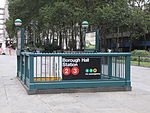Garfield Building (New York City)
1925 disestablishments in New York (state)Cultural history of New York CityDemolished buildings and structures in BrooklynHistory of Brooklyn
The Garfield Building was located at 26 Court Street and Remsen Street in Brooklyn, New York. It was built by contractor William Lamb, who was originally from Glasgow, Scotland. Together with his brother Thomas, the builders began their careers with the firm W&T Lamb, starting in 1861. The seven-story Garfield Building was offered in an auction by the Brooklyn Real Estate Exchange in January 1906. The lot covered 100 feet by 137.6 feet. It was near Borough Hall, the court house, Temple Bar, Hall of Records, the first subway station, and the heart of the financial center.
Excerpt from the Wikipedia article Garfield Building (New York City) (License: CC BY-SA 3.0, Authors).Garfield Building (New York City)
Court Street, New York Brooklyn
Geographical coordinates (GPS) Address Nearby Places Show on map
Geographical coordinates (GPS)
| Latitude | Longitude |
|---|---|
| N 40.69329 ° | E -73.99079 ° |
Address
Court Street 26
11201 New York, Brooklyn
New York, United States
Open on Google Maps










